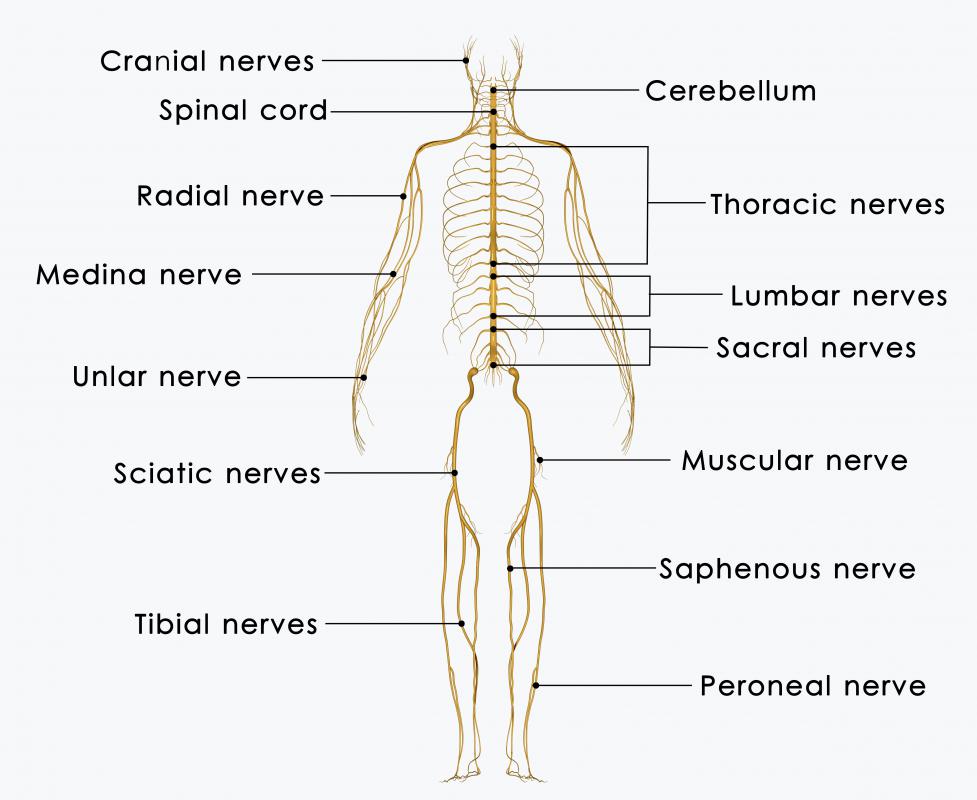At WiseGEEK, we're committed to delivering accurate, trustworthy information. Our expert-authored content is rigorously fact-checked and sourced from credible authorities. Discover how we uphold the highest standards in providing you with reliable knowledge.
What is a Posterior Nerve?
Nerves are fibers that run throughout the body, carrying electrical impulses to and from the spinal cord. They detect sensation, control movement, and allow the body to regulate itself. A posterior nerve, or dorsal nerve, is a nerve that runs along the back side of the body, such as through the back and buttocks, or the back parts of internal organs. The nerves that run along the front side of the body are called anterior nerves.
The nervous system of human beings and other animals with backbones consists of a central nervous system and a peripheral nervous system. The central nervous system is made up of the spinal cord and the brain. The peripheral nervous system, on the other hand, is made up of the 31 pairs of nerves that branch off from the spinal cord and extend throughout the rest of the body. These spinal nerves exist in pairs — one half of the pair connects to the left side of the body while its counterpart connects to the matching right side of the body.

Spinal nerves have a posterior nerve root and an anterior nerve root. The posterior nerve root, often called the dorsal root, is where the sensory information from the body is transmitted to the spinal cord, sending sensation to the central nervous system. The anterior nerve root is where the nerves that transmit motor signals link to the spinal cord.

There are many posterior nerves throughout the body. Any nerve that detects sensation in the skin on the back of the body is a posterior cutaneous nerve. The posterior interosseous nerve supplies the muscles in the back and side of the forearm where the radial bone sits. The posterior cord is part of a large group of nerve fibers near the top of the spinal cord called the brachial plexus; nerves that branch from the posterior cord help control and stabilize the shoulder, arm and hand.

The sciatic nerve, the largest nerve in the peripheral nervous system, is a posterior nerve, running through the buttocks and down the back of the thigh through the leg. For much of that distance, it is joined by the posterior cutaneous femoral nerve, which gives sensation to skin on the back of the thigh and other areas. The posterior tibial nerve branches off the sciatic nerve above the knee and runs through the calf of the leg to the foot.
AS FEATURED ON:
AS FEATURED ON:














Discussion Comments
@bythewell - I'm so sorry that that's the case with your brother. There is nothing worse than a condition which doesn't seem to have a solution, because no one is really sure what's wrong.
In some cases sciatica is caused because the sciatic nerve runs through one of the muscles there instead of underneath it, and if the muscle gets tired or inflammed it can strangle this spinal cord nerve.
I think in that case, his best bet is trying to rest as much as possible and maybe take anti-inflammatory medications.
Of course, sciatica is caused by lots of different things that can affect that particular nerve and the only thing he can do is keep trying different doctors until he finds one that can help. I hope your brother does get relief one way or another.
@pastanaga - I've heard of that study as well. All I could think was "the poor frog!"
Actually I've only heard of posterior nerves because of the sciatic nerve, and that's because my brother suffers from sciatica.
They don't actually know for sure what causes it in his case, but he always seems to have an ache in his back that occasionally flares up to become really painful.
Unfortunately, there doesn't seem to be a lot they can do about it at the moment. It's something he's just going to have to live with and hope will eventually feel better. He has talked with other people who suffered the same thing and in some cases it does seem to go away, sometimes after years of suffering.
Of course, that's not much comfort to him at the moment.
This makes me think of a study my father told me about which involved the posterior nerves. Dad used it as an illustration when I was a kid that truth was stranger than fiction.
Apparently some scientists did an operation on some frogs where they remove the skin from their stomaches and switched it with the skin from their backs.
They then (presumably after the frogs had healed) tickled the switched areas.
The frogs would scratch at where the skin used to be, rather than where it was now. Even though the nerves had moved, they were still registering as the nerves that should be in a certain place, and the frog responded accordingly. Weird, huh?
Post your comments